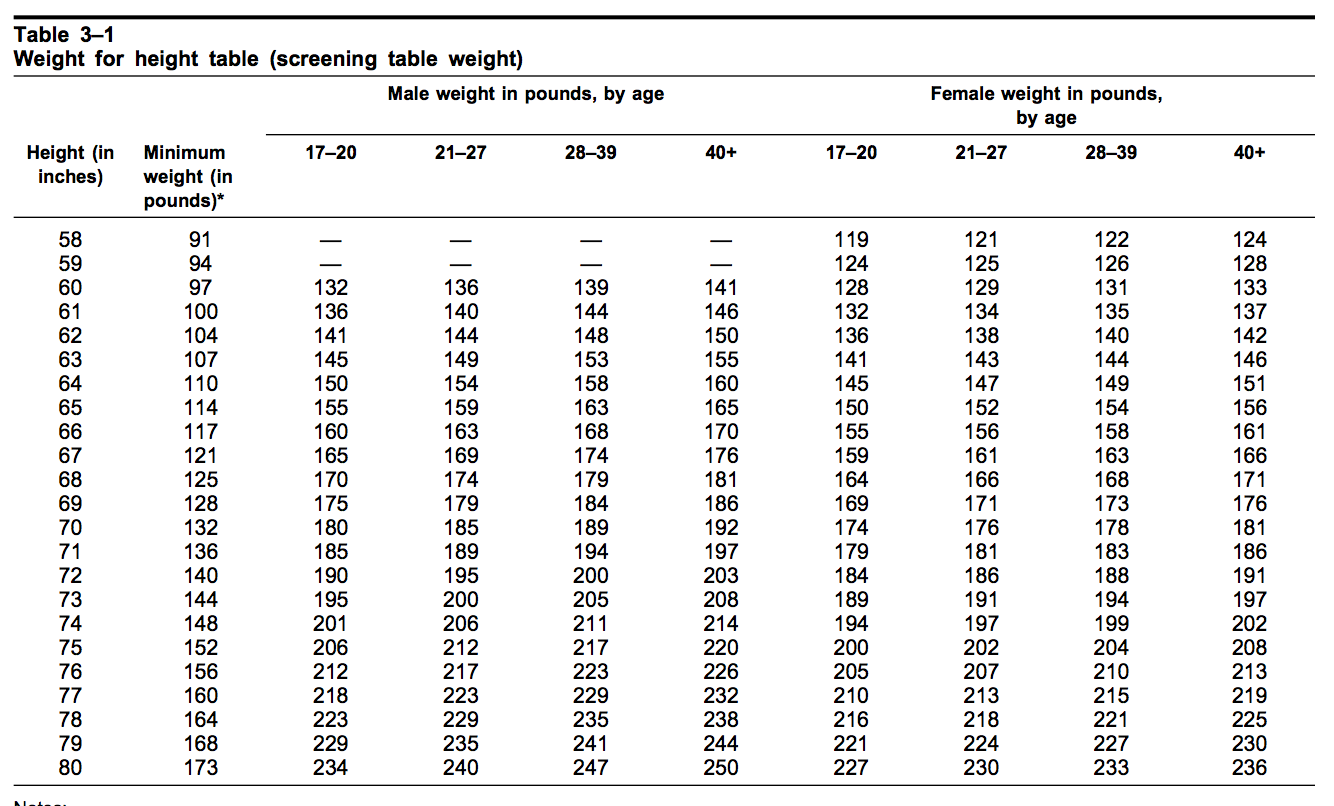The Army Height to Weight Chart is an essential tool used by military organizations to ensure that personnel meet specific physical standards. Maintaining an optimal weight relative to height is crucial for operational readiness and overall health. In this article, we will delve deep into the importance of this chart, how it is structured, and what it means for both current and aspiring military personnel.
Understanding the Army Height to Weight Chart is not just about meeting the minimum requirements; it reflects the commitment to physical fitness that is vital in military service. For those considering a career in the armed forces, being aware of these standards can be the difference between acceptance and disqualification. This article aims to provide a thorough understanding of the chart, including how to interpret it and its implications for service members.
In addition to exploring the specifics of the height and weight requirements, we will address common myths, the impact of body composition on assessments, and provide tips for maintaining a healthy weight. So, whether you are preparing for enlistment or simply looking to understand military fitness standards better, this guide will serve as your comprehensive resource.
Table of Contents
- What is the Army Height to Weight Chart?
- Importance of the Army Height to Weight Chart
- How to Read the Army Height to Weight Chart
- Biological Factors Influencing Weight
- Common Misconceptions about the Chart
- Impact of Body Composition on Assessments
- Tips for Maintaining Healthy Weight
- Conclusion
What is the Army Height to Weight Chart?
The Army Height to Weight Chart is a guideline established by the United States Army to determine whether a soldier's weight is appropriate for their height. This chart is designed to ensure that all personnel maintain a healthy weight that is conducive to physical performance and overall health. The Army evaluates soldiers based on their height and weight measurements at regular intervals throughout their service.
Data and Statistics
The Army regularly updates the height and weight standards based on various health guidelines and statistical data. For instance, according to the Army Regulation 600-9, soldiers must adhere to specific weight limits that correspond to their height. These limits are derived from extensive research on health, fitness, and performance.
Importance of the Army Height to Weight Chart
The Army Height to Weight Chart serves several vital purposes:
- Operational Readiness: Maintaining an optimal weight ensures that soldiers can perform their duties effectively.
- Health and Wellness: Weight management is crucial for reducing the risk of obesity-related health issues.
- Uniform Standards: The chart helps maintain uniformity and discipline within the ranks.
How to Read the Army Height to Weight Chart
Reading the Army Height to Weight Chart is straightforward. The chart lists height measurements on one axis and weight limits on the other. Soldiers can find their height and then check the corresponding weight that falls within the acceptable range.
Example of the Chart
For example, if a soldier is 5 feet 10 inches tall, the chart will indicate a specific weight range that they must meet to comply with Army standards. Failure to meet these standards can result in corrective actions, including mandatory weight loss programs.
Biological Factors Influencing Weight
Various biological factors can influence a soldier's weight, including:
- Age: Metabolism tends to slow down with age, affecting weight management.
- Gender: Men and women may have different body compositions, influencing weight standards.
- Genetics: Genetic predispositions can affect body shape and weight distribution.
Common Misconceptions about the Chart
There are several misconceptions surrounding the Army Height to Weight Chart:
- Muscle vs. Fat: Many believe that the chart does not account for muscle mass, leading to misinterpretations of health.
- Rigidity of Standards: Some think that the standards are inflexible, while the Army does consider body composition assessments.
Impact of Body Composition on Assessments
Body composition plays a crucial role in the Army's evaluation process. Soldiers who may not meet the weight standards can still pass their assessments if they have a healthy body fat percentage. The Army uses additional tests, such as waist circumference measurements and body fat assessments, to provide a more comprehensive view of a soldier's health.
Tips for Maintaining Healthy Weight
For those looking to maintain a healthy weight, consider the following tips:
- Balanced Diet: Focus on a diet rich in whole foods, minimizing processed foods and sugars.
- Regular Exercise: Incorporate both cardiovascular and strength training exercises into your routine.
- Hydration: Drink plenty of water to stay hydrated and support overall health.
- Sufficient Sleep: Aim for 7-9 hours of sleep to aid in recovery and weight management.
Conclusion
In conclusion, the Army Height to Weight Chart is a critical component of maintaining the physical standards required for military service. It not only helps in ensuring operational readiness but also promotes overall health and wellness among soldiers. Understanding how to read the chart and recognizing the factors that influence weight can empower current and aspiring military personnel to meet these essential standards.
We encourage you to share your thoughts on this topic. If you have questions or personal experiences related to the Army Height to Weight Chart, please leave a comment below. Additionally, feel free to explore other articles on our site to continue your journey toward understanding military standards and health.
Thank you for reading, and we hope to see you back for more insightful articles!
You Might Also Like
Drake's Love Life: A Journey Through Romance And RelationshipsAbove The Knee Tattoo Ideas: Unique Designs To Inspire Your Next Ink
Lexi 2 Legit Leaks: Everything You Need To Know
Does Drake Have A Girlfriend? A Deep Dive Into The Rapper's Love Life
ITZY Ages: From Oldest To Youngest Members
Article Recommendations


